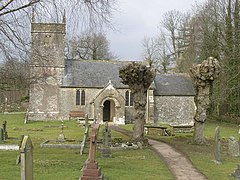Holcombe, Somerset
| Holcombe | |
|---|---|
 The old St Andrew's church, Holcombe |
|
| Holcombe shown within Somerset | |
| Population | 947 (2011) |
| OS grid reference | ST675495 |
| District | |
| Shire county | |
| Region | |
| Country | England |
| Sovereign state | United Kingdom |
| Post town | RADSTOCK |
| Postcode district | BA3 |
| Dialling code | 01761 |
| Police | Avon and Somerset |
| Fire | Devon and Somerset |
| Ambulance | South Western |
| EU Parliament | South West England |
Holcombe is a small village and civil parish (population 936) in the Mendip local government district of Somerset, England. The parish contains the hamlets of Barlake and Edford. It is within easy commuting distance of both Bristol and Bath.
Its place name is derived from the Old English Hol, meaning deep or hollow and cumb meaning valley.
The parish of Holcombe was part of the Kilmersdon Hundred.
The original medieval village was buried at the time of the Great Plague of London, and the old parish church, which survives, is surrounded by the mounds that bear testimony to this burial. It is suggested that the rhyme 'Ring a Ring o' Roses' began there as a result. An alternative explanation relates to the drowning of five children from the village in an icy pond in 1899.
The village has two pubs: The Duke of Cumberland, which can be found at the bottom of the village's hill, and the Holcombe Inn, which recently changed its name from The Ring O' Roses to its original 1960s name. It was named as a reminder of the plague that previously destroyed the village.
Holcombe has four churches, two of which are still in use.
Holcombe was the site of several mines on the Somerset coalfield; however these are all now closed. The importance of Somerset coalfield caused a branch canal from the main Dorset and Somerset Canal to be proposed, and construction began in 1786 following a route from Coleford, Somerset to Nettlebridge through Holcombe. This intersected the main road through Holcombe around 75 m north of the Duke Of Cumberland inn. However, in 1803, the entire canal was abandoned without being completed. There is limited evidence of the canal remaining, including some masonry such as bridges and retaining walls near the Duke Of Cumberland.
...
Wikipedia

